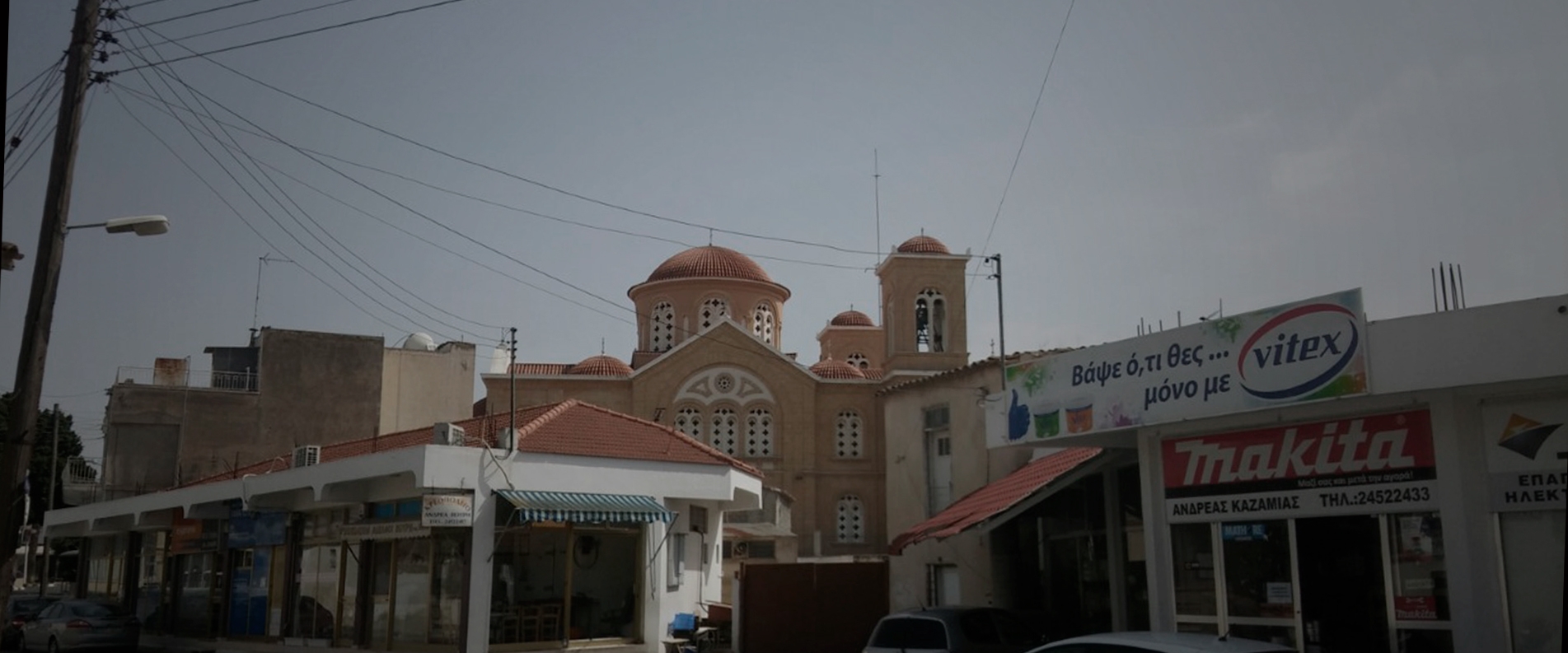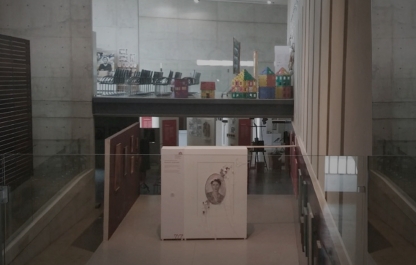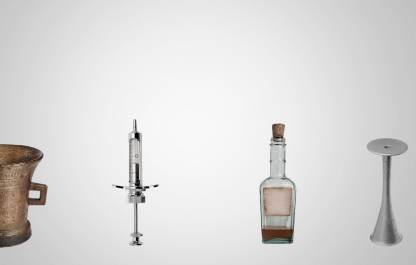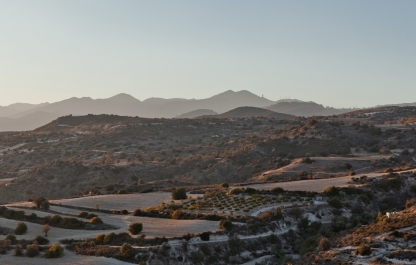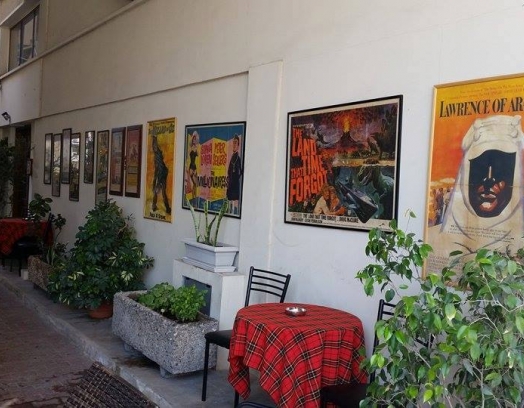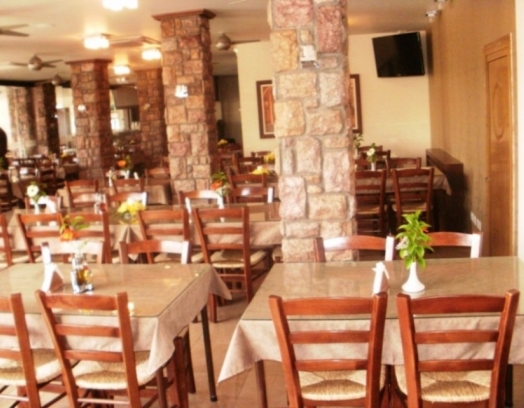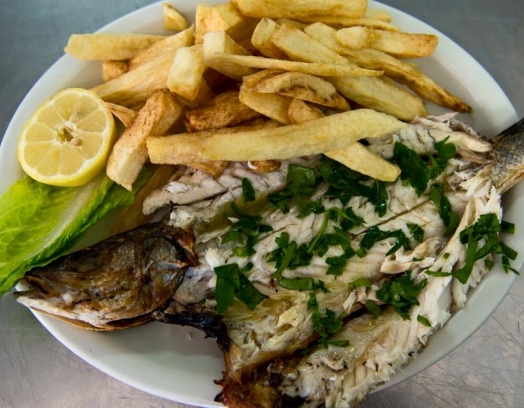Here is another part of our tour around Cyprus villages and their neighborhood. As always you will learn about the history of the region and its people and know more about the daily life of the locals. You may notice Athienou has something in common with other villages we’ve already visited but it is not without its own unique charm. Despite the island is quite small, this is true for the most villages in Cyprus.
The final destination today is Athienou village — one of the oldest on the island. Its history is dated back to the third century BC and the remains of the settlements near it are even older, holding the traces of the long-vanished civilizations.
Meanwhile modern Athienou, as is often the case in Cyprus, is more like a small town with its own municipality that has been in place since 1926. The village grows and develops dynamically at the same time it transmits and preserves its cultural heritage.
The origin of the name is still a question worth debating. There are several versions of it existing simultaneously.
The most common of them says that the name “Athienou” comes from “άττα” or “άθθα” what means “a big stone/rock”. That could be true because there are plenty of big boulders near the village and the soils here are stony as well.
According to the other version the name was given due to the Athenians who were first settled in this region back in time.
There is also the third explanation that finds resemblance of the name of the village with the Lusignan feudal named Etienne. They said Cypriots who were going to his house mentioned it as “Ethiennes Place” (“πάμε στου Ετιένου” in Greek). In later years that phrase changed to “Athienou” (“στην Αθηένου” in Greek) and was used to describe the whole fief. Sounds convincing, right?
-
Athienou village is located on the Mesaoria plain in the Larnaka district, right in the middle between Nicosia and Larnaka.
About 65% of its territory (circa 50 ha) is occupied by Turkish troops since 1974. Because of the fact that the surrounding area is a part of the buffer zone, the road signs and the watchtowers constantly keep reminding you about it, it’s like you fall out of the summer vacation’s serene atmosphere you can feel in other parts of Cyprus. Anyway the landscape of the Athienou village is beautiful and the trip to it can be an interesting adventure by itself.
Please, be careful and read all the prohibition signs not to step into the restricted areas. Aside from that it’s as safe as in any other part of the Cyprus.
Now we are here…
Athienou village today is a densely populated place once famous by the food made by the locals. “Athientiko” — the local kind of bread has been popular for years and homemade yoghurt together with Halloumi cheese are well known for their taste quality and traditional recipes. One of Cypriots favourite snacks — roasted peanuts is also produced here.
Skillful craftsmen are another pride of this region, “plumia” and “olopluma” kinds of “Venetian” lace are widely known. Athienou is considered to be the region of the unique and authentic architecture, reserve of the “true” Messaorian style. Well, the streets here look really original, add to that few old houses with their own history we would tell you a bit later in more details.
The patron Saint of the village is Agios Fokas, there is only one church to his honour in the whole Cyprus and it is located here. You can find it turning to the right from Agiou Georgiou Church near the old market. We’ll get back to it soon.
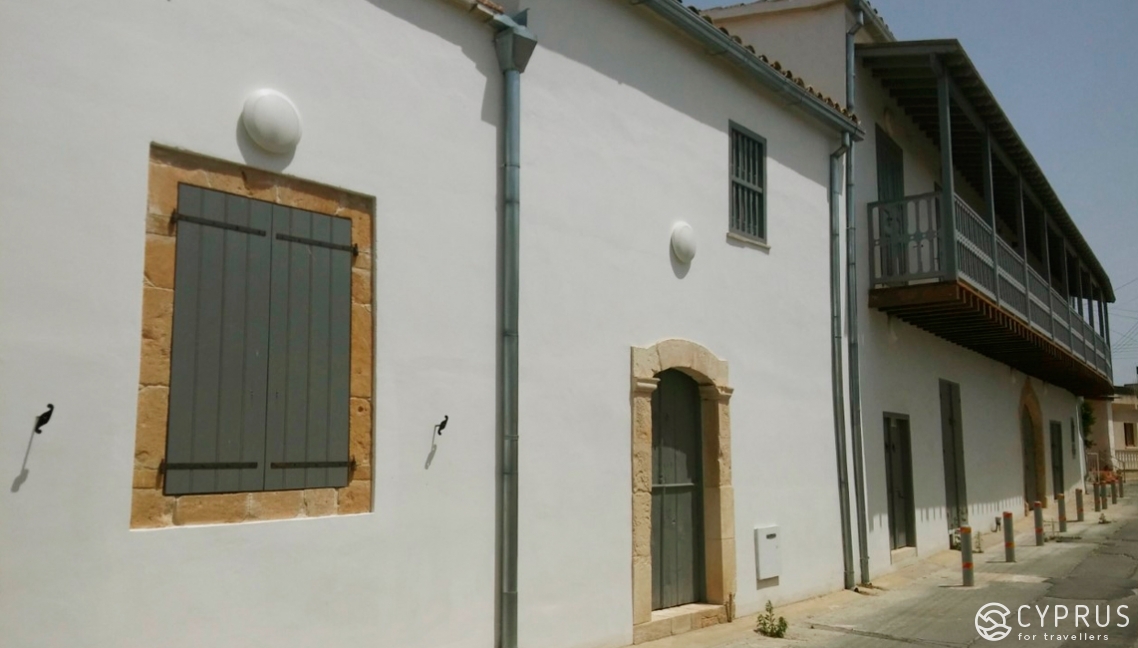
The population of the village is about 6 thousand people, including both locals and foreigners.
The traditional occupations are represented mainly in agriculture: wheat farmers, livestock and dairy industry.
There are 6 churches, elementary and secondary school and a lot of architectural monuments and historic landmarks, including old Mestanas building — Mestanas-Inn.
The members of the community take part in the local cultural life: visit different workshops often organized in the Municipal museum of Athienou.
Among the famous landmarks of its surroundings are the remains of ancient city Malloura and Golgoi, the second one is now located in the occupied territory, to the North-West from the village.
-
Our first encounter of Athienou village began with the one of exhibitions of Kallinikeio Municipal Museum as you might read in the previous article. We’ve had the opportunity to walk around the village after that thanks to the hospitality of our new friends, go sightseeing, visit several interesting museums and even make some small discoveries. But, as the saying goes, first things first…
It’s not a secret that the highest value of every place is its people. So this region is rich with wheat crop and outstanding crafts but remarkable people as well.
So, we are heading down the streets bathing in the afternoon sun to the Kallinikos father’s house.
Museum of Kallinikos Stavrovouniotis
Let us tell you first about a famous person — monk Kallinikos who was born in Athienou and became famous all around Cyprus and even abroad.
His birth name was Kostas and he was the third child of the family of cheese and dairy makers Petros Mammous and Florentia Liontari.
There is a photo in one of the rooms (I’ll tell you a bit later in which one exactly) in their house with parents holding the baby future icon painter in their hands.
Young Kostas entered the Stavrovouni Monastery as a novice monk in 1941 despite his fathers wish and took the name Kallinikos (Καλλίνικος in Greek). He was showed a great talent and interest in icon painting in the monastery and learned the basic principles under the guidance of the monks Meletios, Dionysios and Stefanos.
In 1946 he continued exercising his art and apprenticed to father Ioannikios Mavropoulos in the Mount Athos. Soon after his death Kallinikos came back to Cyprus, however he continued to go to Mount Athos from time to time for whole his life.
He also became an active member of EOKA during the EOKA Struggle (1955-1959) fighting for the independence of Cyprus and was incarcerated in the British jail where he spent three years without stopping painting icons.
A major turning point in his life was his apprenticeship by the famous Greek icon painter Photis Kontoglou who influenced the young monk to shift to the Byzantine technique supported by the Archbishop of Cyprus Makarius III.
Apart from that Kallinikos apprenticed also by the icon painters in the Trinity Sergius Lavra in Russia and studied Byzantine style icon painting in Cyprus. Many of his works were exhibited in Cyprus and in other countries. He published a book about Byzantine icon painting techniques in 1996.
Kallinikos worked until his death on the 23th of January 2011 in the Stavrovouni Monastery where he created many of his works. The icon workshop of the monastery is now open for both men and women. Kallinokos was also the one of the most generous patrons of his birthplace — Athienou village.
And now here we are, in the house of the Kallinikos’ father: tiny rooms of the first floor tell about the works of the monk and his religious deeds. There is a memorial studio to the right from the exit where you can see clerical clothing of father Kallinikos, his paints and paintbrushes and a camera collection surrounded by his finished and unfinished icons and drawings of the church murals.
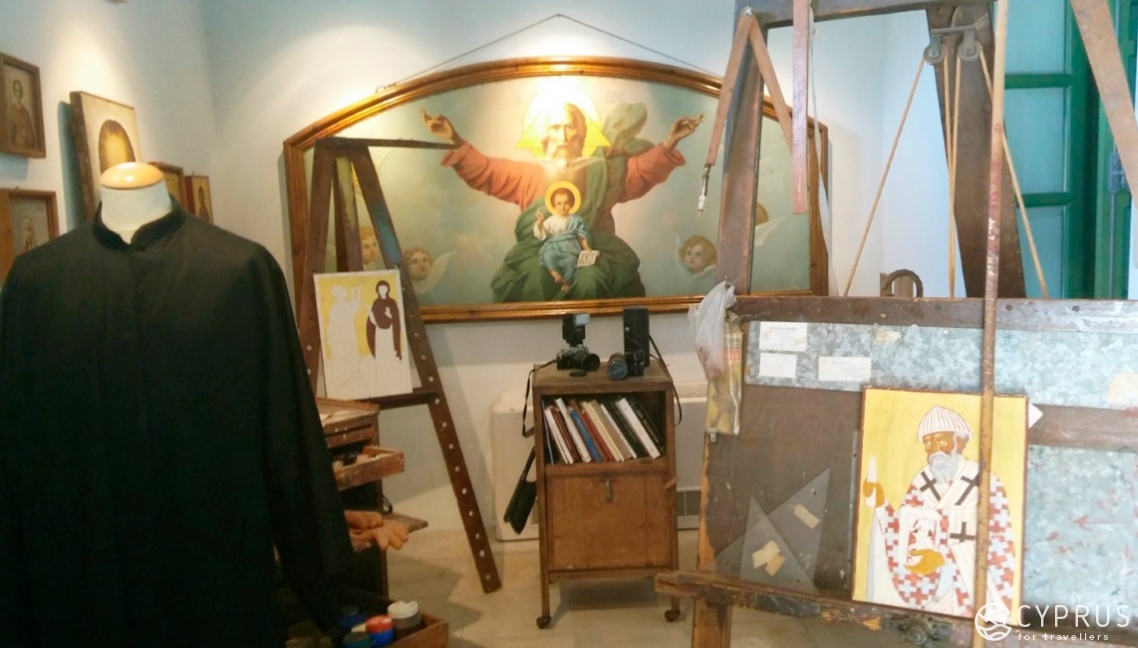
Another hall [1] is situated in front of the studio: here you will find portable icons depicting Saints, Apostles and Archangels on the golden backgrounds and the wall with the painted Cross and the inscription: IC.XC.NIKA (Jesus Christ wins) discovered under the layers of plaster.
![]()
The interior of the house may not surprise those who already visited a few houses in the Cyprus villages or those who have read our previous articles about that. If you are new here, you can read the article about the Traditional Stone Construction in Cyprus which reveals the architectural rules for buildings that existed for a long time on the island.
This house also has some typical features and here they are: right in front of the entrance to the house there is another passage to the backyard with a fruit garden, a little vegetable patch and an oven. Here is also a dairy that is functional to this day.
It’s a great opportunity to watch the whole process of the cheese making as it was back in time. The whole technology changed very little since than. You can visit one of the many workshops where you will learn about the traditional way of Halloumi cheese producing. It is held with the help of both modern and old things, dishes and tools once belonged to the father of the famous icon painter. We were curious to take a look in there.
The process of the “cooking” happens inside the few vats standing in the spacious shop. It’s interesting that the ovens where the cheese makers heat the milk and cheese yeast are located outside the building. On the opposite the responsible for the heated air convection airway that connects them with each other is installed under the dairy floor.
All the visitors are welcome to join the workshop at the H hour — a special time when all the activities in the old part of the Athienou village start. As far as we know it is held every Thursday, but please, check the next appointment in the local municipality.
We’re finishing our excursion through the backyard and the first floor and going up the stairs followed by one of the museum staff to the second floor where usually the bedrooms of the family members situated. And we were right! We are standing in a small “iliakos” (sunny room or small hall) decorated with embroidery and family photos (here is the one with baby Kallinikos I’ve recently told you about). The door leads to his parent’s bedroom.
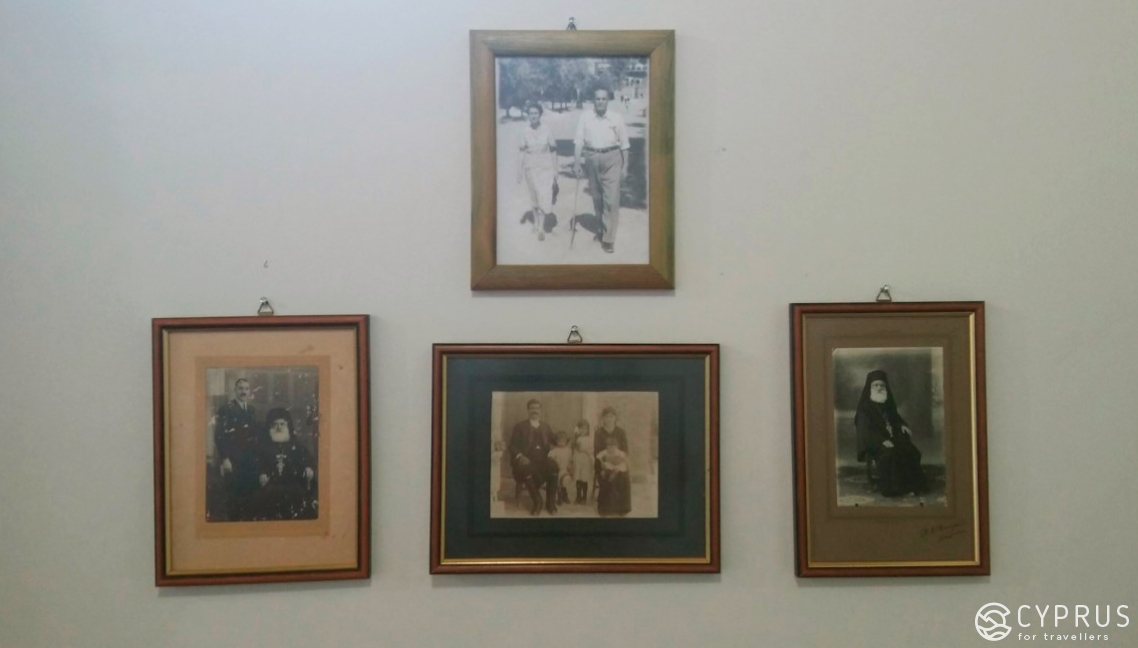
Stepping inside you will notice that the family was quite wealthy: big wrought iron canopy bed, its elegant fabric is richly decorated with lace, high quality carved furniture and even a portable TV set “Yunost” probably brought by the son as a present from the USSR.
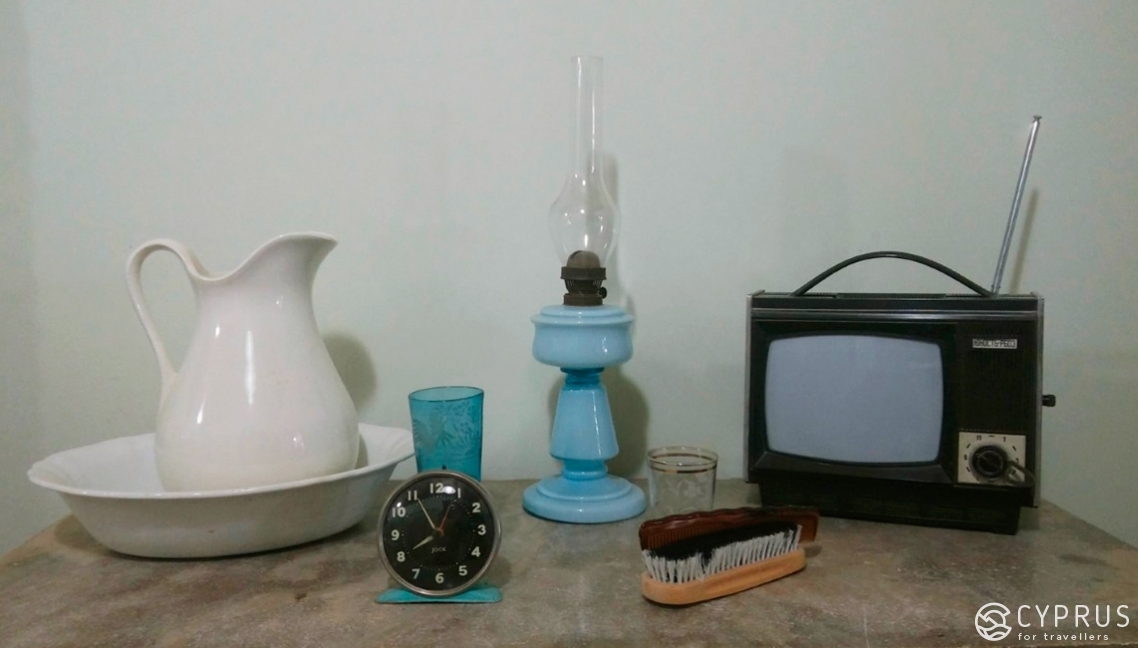
The other door leads to the monk’s bedroom (now a part of the museum) that as expected resembles one of the monastery cells with its simple and ascetic interior. Except the quite small bed and a wardrobe there are a wicker chair, a stack of three huge suitcases and the only bright thing in the whole room — a painted pitcher on the windowsill near the hanger with clothing, that’s it.
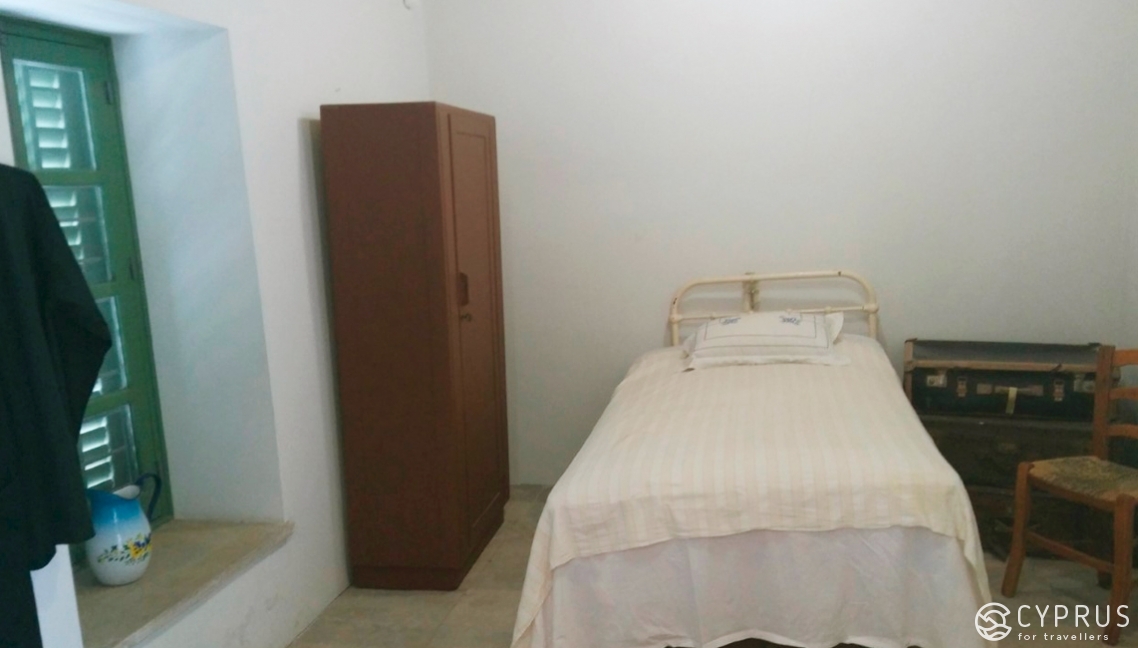
I should admit that standing there in a quiet small house imagining a big and close family that lived there made me feel something quivering deep inside. After all knowingly say that the house usually keeps the spirit of its hosts for a long time after their death. So we can realize the magnificence of the faith of father Kallinikos, who was a man of great intelligence and had an inner light indeed.
The last place on the territory of the museum we want to tell you about is also connected with the cheese making. It’s an old shop owned by the family. Unfortunately it was closed by the time we came there. Of course cheese is one of the key ingredients in fast every menu, but as the proverb says: bread is the staff of life. We’ve noticed a big oven for bread baking while we were going out of the museum doors. That kind of ovens is also used in many Cyprus villages for making tavas (lamb baked with rice and vegetables).
And now we are going closer to the old mill that has its own no less interesting story to tell.
The Mill
It is another museum and cultural centre of crafts in Athienou. The mill was owned by Chatzitheocharous family for a long time.
The villager named Charitos built it in 1910. The mill worked by using steam engine and firewood. Michalis Chatzitheocharous became an owner in 1920s and replaced the steam engine with the diesel engine after several years after that. It was 16 horsepower and in 1934 his son installed another one [2] that was even more powerful (46 horsepower). This change marked the start of the new period in the local processing of wheat. The owner not only increased the amount of produced flour but also made some kind of “coffeeshop” out of the mill: it stayed open till the late in the evening and was the place where the locals met after the work. People came to the mill to have a nice time with the cup of coffee and sometimes even to resolve their disputes and litigations. The miller was famous for his wise and skills to find the appropriate solution.
In 1960s the mill led by Andreas served the whole Athienou and several neighbor villages as well: Melousia, Tremetousia, Agia, Petrofani, Troulloi, Tymbou, Piri, Geri and Avdellero (according to the memories of the local woman and the descendant of the miller family — Panayota Chatzitheocharous-Koulouridis, 2013).
There were three millstones each used for the different kind of the raw material: one for malt, one for wheat and one for bulgar wheat production. The mill offered its services to numerous clients until 1974 when the work almost stopped: at this time the mill was used mainly for milling the livestock feed and the wheat flour was produced only in small amounts.
In 2000 the mill was owned by one of the artists brothers Kepolas — Alkis. In 2004 the municipality of Athienou bought the legendary mill with a view to develop the tourist industry and preserve the local traditions.
As we were told in the Municipal Museum, calling the mill a centre of bread baking today is mainly a tribute to the old times. There are only two traditional bakeries today, as it often the case in Cyprus, one located near another: Kazazis Bros Bakeries on Christou Kazazi Street and Sergiou Bakeries on Morfou Street.
Aside from that the local women bake the famous bread from time to time in their ovens in the backyards and of course its not for sale.
You probably will find only the so-called “mass production” kinds of bread in other bakeries in Cyprus.
And what is going on in the mill today you may ask me
The secret of the famous Athienou bread is in the quality of the wheat that is grown here since ancient times. The whole Mesaorian plain was known for its grain-growers that used the convenient geographical location and climate to their advantage.
So, every Thursday in the old mill (attention to gourmets, devoted cooks and all who is interested, the following information is for you!) the local master baker holds a baking workshop where he shows all the steps of turning wheat grains into the warm fragrant bread to school groups and all comers.
You can also take part in the process; please, contact the Athienou municipality for more detailed information of how to join the group in Larnaka (see also the information at the end of the article).
The Old Fountain and Water Reservoir
The old fountain and water reservoir is a square shaped construction that is located not far from the old building of Archontiko tis Anastasias inn on a small square lined with stone. You can pour yourself some water using a tap on the one of its sides. Here is also written the exact year of construction — 1909.
This fountain is the biggest of all the old ones I’ve seen before. However the record holder among all plumbing constructions except the ancient aqueducts is hailed by many poets Fountain of Pegeia.
Churches
Agiou Foka, Agiou Georgiou, Panagia Chryseleousa Churches, both the Old and the New one with the relic: shoes of the Saint Spyridon of Thrimythous.
The Old Panagia Chryseleousa Churche (built in 1711) stands near the new building where the shoes of the Saint Spyridon of Thrimythous are hold. Not far from these two churches you can see Agiou Georgiou Church (built in 1880) and you will find Agiou Foka Church (the only one in Cyprus dedicated to this Saint) going down the main street.
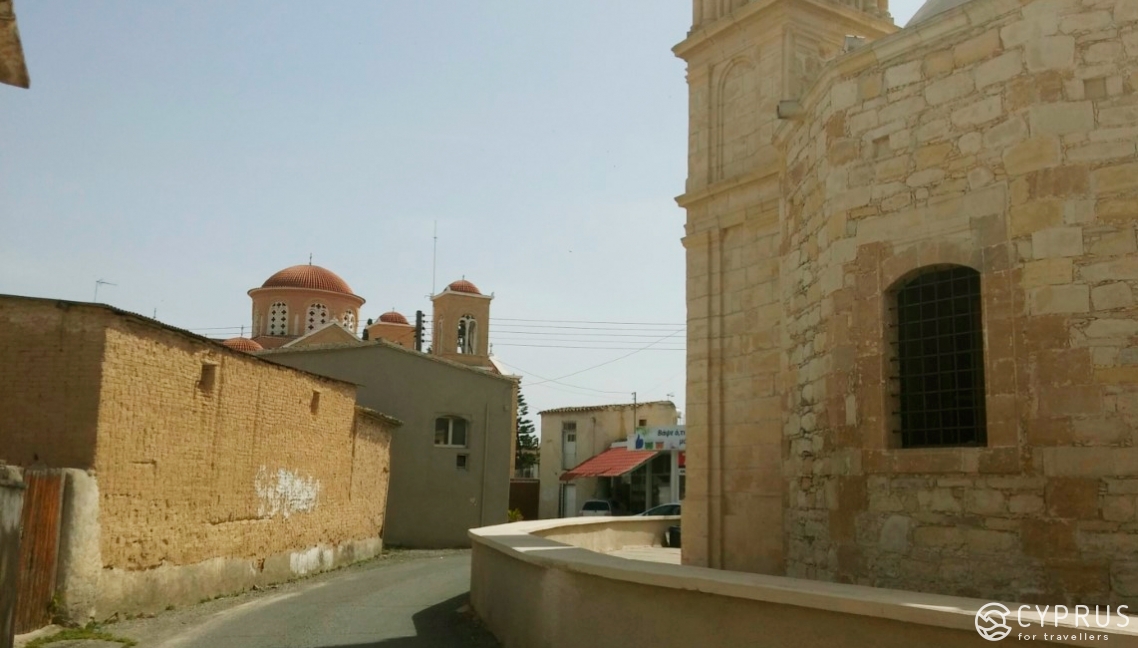
You can visit all the churches by foot; leave the car on the free territory near the 1st April Street or on the central parking in front of the municipality building. Walk the Arx. Makariou Ave and then along the Evagorou Ave. Here are two museums we’ve already visited today: the first is Kallinikos Municipal Museum with its icon collection, studio and personal belongings of the famous monk and dairy with its traditional lifestyle and the second one — the old mill with its exhibition showing the process of bread baking. Turn to the right to 9th July Street that connects with the 1st April Street to the left.
The first church you will see following this way will be Agiou Georgiou Church, than Agiou Foka Church (just turn to the right on St Fokas Street; the Feast of the Holy Martyr Saint Fokas [3] is celebrated annually on the 21st and 22d of September in Athienou). Go back to the Toumazou Street and down it to the Old (1711) and New Panagia Chryseleousa Churches where the relics are kept.
Let me tell you about life and deeds of the Saint Spyridon of Thrimythous
Saint Spyridon (c. 270-348) was born in Cyprus and after his entering of the monastery became Bishop of Thrimythous (and Salamina). His feast day is now celebrated on the 12th of December according to the Orthodox tradition and on the 14th of December in the Catholic world.
Since the childhood he worked as a shepherd and helped harvesting the wheat. He was known for his great piety. As a reward for his kindness he had a gift from above: the ability to heal and prophecy as well as to banish evil spirits out of the mad. He was married and had a daughter who entered a convent after the death of his wife.
According to the legends a number of miracles are connected with the Saint: a prolonged dry season suddenly ended with the rains, greedy and cruel men got what they deserve and people recovered from their diseases (including suffered from severe illness Emperor of the Roman Empire Constantius).
Because of this reason Saint Spyridon is often painted together with Saint Nicolas in one icon.
Saint Spyridon also was one of the members of the First Council of Nicaea convened by the Roman Emperor Constantine I in AD 325.
His relics were kept in Trimythous, Cyprus till the end of the seventh century, but then they were transported to Constantinople because of continual Arabian raids. The next time the Christians should hide their relics was in the fifteen century after the capturing the city by the Turks. So the relics of Saint Spyridon travelled to Epirus on the Balkan Peninsula. The church to honour of the Saint Spyridon was built in Corfu in 1589. The relics are kept there ever since. The part of them was found in Rome and was transferred to Corfu in 1984.
According to witnesses, the relics have imperishable power and a temperature of living being.
And now I want to tell you about the famous shoes of Saint Spyridon of Thrimythous. You may have heard about them not only in Cyprus but also in Greece or in Russia. The legend says the shoes wear out while put on the relics. The clerics have to change them every year. Impressionable religious people who arrived to kneel before the relics tell each other the stories that sometimes there is even a sea sand to be found on the shoes. The seamen tell about the appearance of the Saint when they got into dangerous situations out in the sea during storms.
There are other stories told by the priests themselves on the forums on the Internet that keep alive the belief that Saints never leave people alone and always care and pray for them. And sometimes even walk among us doing good in the name of the Lord like Saint Spyridon.
One pair of those shoes that were worn out (wine-red velvet embroidered with the golden threads) you can see now in the New Panagia Chryseleousa Church in Athienou. Religious people believe that the relic has power to heal and to give wealth, if you sincerely ask Saint Spyridon for help.
It’s worth to visit all the churches even when you are interested more in history and culture than in religion. The churches with their beautiful murals are unique architectural works to pay attention to.
Each church has also it’s own specialization and offers different types of prays for an order. And if you are planning to come to Athienou in the Sunday morning, you can ask the clerics in the New Panagia Chryseleousa Church for the opportunity to see the famous shoes.
How to get to Athienou
By car: from Nicosia — about 43 km (the travel time 40 min) on the highway Nicosia-Larnaka (A1-A2 roads).
From Larnaka: 25-30 km (the travel time 27 min) down Akropoleos Avenue through Aradippou (a town on the outskirts of Larnaka) and turn to the highway Larnaka-Nicosia (A2) on the roundabout driving to the road sign to Athienou.
The most convenient and spacious parking lot is in the centre of Athienou, near the Municipal Museum.
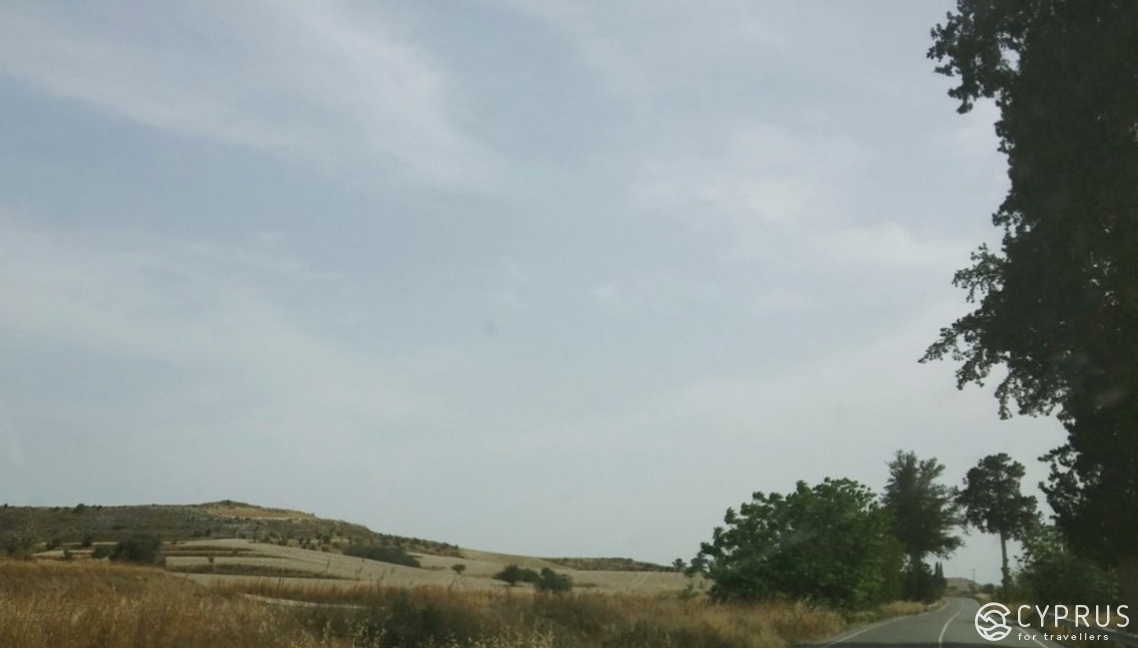
We’ve left Athienou by taking E201 route and were heading to the archeological campsite where Cypriots together with the American scientists from the Davidson College continue their collaborative studies for several years.
It was the first time we decided to leave the main road and there were a pair of unexpected surprises waiting for us.
The first one was a temple of Shiva [4]. Yes, you heard that right — real Hindu mandir located inside the one-storey tiny village house surrounded by fields and groves extending to the horizon, its bright red and silver flags fluttering in the wind.
While we were passing by the temple, one of the priests (called pujari) that stood there together with two dressed in elegant sari women smiled and waved to us.
Excited we kept driving and very soon discovered a great view of a big hill with the abandoned village on the top of it. The crows were flying here and there over the houses built out of the white stone. It was magnificent but very sad spectacle.
Here is brief information about this place.
Abandoned Petrofani village and sites near it: Malloura and Golgoi
Petrofani (Esendağ in Turkish) — is a long abandoned village located 2,5 km away from Athienou. Before the occupation of Cyprus by Turks there lived only the Turkish Cypriots that moved to the North after it.
A little friendly advice: please, do not climb up the hill to explore the buildings in search for extreme experience. Many buildings are ruined or in critical condition. And as it’s often the case in Cyprus, usually there are a lot of snakes in the abandoned settlements. Playing the explorers will be a bad idea especially during the heat in the summer months: there is a high chance to run into a snake or a scorpion.
And furthermore looks like the local farmers and cattlemen that keep cows made there a dump as evidenced the awful smell and the flocks of crows.
So you would better stay on the road (by the way a paved one) and observe the village from the distance. It will be more than enough to imagine how it looked like 40 years ago.
-
To get to the one of archeological sites of Malloura you should go right round the hill. Our new friends from Athienou told us that the territory would be closed for visitors by the time we would reach it. What is more, the recent heavy rains have washed out the dirt road and there were no point in slogging through a mudhole except you are driving a Jeep.
A small hint: you will avoid this road if you choose E322 route heading from Athienou into the fields. This road is paved according to the notes and photos of other travellers and will lead you to the same place but with more comfort.
During the opening hours you can walk through some parts of the archeological site and visit a few objects in the open air. Ask about the opening hours and other details in the municipality.
So it were some facts about the place and if you want to experience the archeological work [5] in the first person, you can watch this video, made during the expedition by one of the American archeologists.
Malloura
Both Malloura and Athienou are located on the plain (total area of 26 hectares) that contains a wealth of archeological material. The scientists are studying the archeological finds [6] to present in detail the lifestyle of the people who lived there in the Archaic and Hellenistic periods. The latest burials discovered on this territory are dated back to the Venetian and Ottoman rule in Cyprus. According to the archeologists Malloura has experienced its highs and economic growth during the Venetian rule in 1489-1571, but the settlement faced its lows during the Ottoman rule getting smaller and was abandoned by its citizens in nineteen century.
The archeological object includes the remains of the settlement (housing structures, storage facilities and more likely weaving works specialized on processing of flax) and big industrial building as well as local temples, stone graves and other burials of different ages and folks once lived in this region.
-
To anyone who is strongly interested in Cyprus archeology we recommend to read about the results of expeditions in Malloura over the last 20 years that are summed up and available here (written by Michael K. Toumazou and Derek Counts).
Previously, before the Turkish occupation, there were excavations in Golgoi, on the site of the Haghios Photios Church and in the place called Bamboulari tis Koukouninas.
You can find the detailed representation of the history of these places and the description of the archeological sites in the local super museum (I can’t help showing my excitement about it, sorry!). It’s the best place to look for the key information and visual materials.
Besides Malloura we want to tell you about one more landmark near Athienou village — Golgoi. The place is now a part of the occupied territory, so the safety status of the archeological site is unknown.
Golgoi site (probably a city)
This settlement is located 1,6 km to the North-East from Athienou village and 17 km to the North, North-West from Kition. The area on the flat hill was inhabited since the Neolithic and remains now one of the most mysterious archeological sites in Cyprus.
It’s generally believed that the founder of the city was Golgos from Sikyon in the Peloponesse (it is mentioned in the ancient sources that he is the son of Aphrodite and Adonis).
Inscriptions attest an Aphrodite Golgia whose worship was, according to Pausanias (ancient Greek geographer and writer lived in the second century BC), earlier than the cult of Aphrodite in Paphos. And although the historians know very little about the existence of the kingdom of this name, some coins that were found among the ancient treasures have been attributed to it. According to the excavations near Bamboulari tis Koukouninas to the North of Athienou that were held in 1969, before the Turkish occupation, the city of Golgoi seems to have flourished to the end of the fourth century BC. The other part of the city remained populated till the Early Christianity.
The further connection is illustrated by an archaic limestone block together with the carved stone sarcophagus that were found here (now both artifacts are in the Metropolitan Museum, New York). Carved in relief on the limestone block is a Chimaera, the symbol of Sikyon, which appears on its coins. The relief of the sarcophagus shows Perseus carrying the head of Medusa and there is an elderly man among other figures, who probably, as historians suggest, represents the occupant of the sarcophagus.
Numerous tombs that were found on the plain and within the limits of Athienou originate as a result of the wars that, according to the stories [7], Golgos waged against his neighbour — city of Idalion.
Illicit excavations near Iorkus and Haghios Photios Church were held in 1867 and in 1870 by the infamous consul of the USA in Cyprus Luigi Palma di Cesnola. With his assistance, many necropolises were plundered: several thousands of funeral sets, sculptures, as well as steles, reliefs, sarcophagi and many other archeological treasures were smuggled out.
I want to remind you a story about the ship that was loaded with treasures excavated probably in every ancient polis of Cyprus and which sank in the Mediterranean Sea. As they told it’s still there keeping all its treasures on the floor of the Sea. However 6 thousand archeological finds from Malloura were transported “safely” and became a part of the Metropolitan Museum collection about Cyprus in 1873. This “collection” [8] is the biggest and the most extensive in the world.
First scientist who linked Athienou with the location of the legendary ancient Golgoi in 1851 was Greek educator Athanasios A. Sakellarios.
The next archeological excavations in the upland of Iorkus were held in 1969-1972 by Aristotle University in Thessaloniki under the lead of Giorgios Bakalakis.
At this time the Department of Archeology of the Hebrew University of Jerusalem — the Institute of Archeology excavated in Bamboulari tis Koukouninas. The ceramics from the backyards of the remains of the houses that are dating from late Bronze Age (1600-1050 BC) were found here. There are evidences of the copper production and trading: many copper items were found in the site as well as the places they were produced at.
Starting from 1990 scientists from the Davidson College of North Carolina that I’ve mentioned before began excavations in Malloura, leaded by Michael K. Toumazou.
Since then were discovered: several settlements, a temple and tombs from different ages (Cypro-Geometric and Archaic periods, Roman rule (1050-330 BC), Venetian rule (1489-1571) and Ottoman rule (until 1878)).
Some late news as a conclusion:
Cyprus Mail from 8th of February 2018 shared the good news with the Athienou citizens: it was decided to put Athientiko bread and the local Feast of the Holy Martyr Saint Fokas, Patron of Athienou on the Unesco National Intangible Cultural Heritage List, which guaranteed the worldwide protection.
And the traditional lace craft “Olopluma” is already on this list.
For more information click the link.
On the 1st of June 2018 (Children’s Day) there was a festival for children and families in Athienou. Read more on the municipality website.
There is also information about the planned renovation works on this website:
The first priority for the local administration is to preserve the famous “Mesaorian” architecture which beautiful examples and characteristic features you can see here and there in Athienou.
Another latest trend is to keep to the principles and shapes of the traditional architecture while building new objects for their better integration to the face of the village.
The old market (Δημοτικη αγορα, 1950) was the main centre of trade in the region until 1974. Citizens of the neighbour villages came to Athienou for shopping. However it’s closed for a long time, there is a modernization plan to turn it into a multifunctional cultural centre. Its rooms will become home for the local choir, dance studio and the community theatre.
An urgent issue remains the building of a sports centre in Athienou that was announced in 2009.
References:
1. A. А. Sakellarios, “Τὰ Κυπριακά” (published in 1855 and in 1890);
2. I.K. Peristianes, “Γενικὴ Ἰστορια τῆς νήσου Κύπρον” (1910);
3. Olivier Masson, Les Inscriptions Chypriotes Syllabiques (1961) and “Kypriaka IX: Antiquités de Golgoi,” (1971);
4. K. Nicolaou, “Archaeological News from Cyprus, 1969,” (first edition, 1970);
5. V. Karageorghis, “Chronique des Fouilles à Chypre en 1969,” (first edition, 1970);
6. The Princeton encyclopedia of classical sites. Princeton, N.J. Princeton University Press. 1976
Until the next time and the new discoveries!
[1] Guided tours in Museum of Kallinikos Stavrovouniotis are offered every Thursday. The guide will tell you about the place and life of father Kallinikos. We’ve walked around Athienou by ourselves, however we had a chance to visit many interesting places thanks to the help of the Municipal Museum staff.
Phone numbers: +357 24524002, 357 24811370; Mail: museum@athienou.org.cy, Website: www.athienoumuseum.org.cy.
[2] The result of the increased capacity offered the opportunity to introduce innovations: simultaneous operating of three mill constructions.
[3] Phocas of Sinope (twelve century) — bishop of the city Sinope and Early Christian Saint, revered both in East and West Christian traditions. He was persecuted by order of the Roman emperor Trajan and died after the fierce torture. Some sources mention that his relics were translated from Pontus (region in the North-East of Asia Minor) to Constantinople about the year 404 AD; the exact location of the relics is unknown though.
[4] Follow the link to see the Yotube video.
[5] The excavations in Malloura are continuing: under the lead of Michael Toumazou and with the help of the students of several American colleges and universities. The department of Antiquities of Cyprus supports the exploration since 1990.
[6] Archeological excavations of the Malloura area (the remains of the ancient temple) were first undertaken by the French mission in 1862.
[7] There is no historical evidence (documented or based on the archeological finds) of this statement. However it is known that the relations between the ancient polises have not always been peaceful and what is more: the wars were a part of the daily life of the locals back in time because they tried to defense themselves against the constant raids to the island.
That fact is proved by the pattern of settlements, as Iorkus for example that had fortifications.
[8] Variations of these stories could be heard all around the Cyprus. Many of them are connected with Athienou and its neighbourhood where the kingdom of Idalion was located. As we know from the chronicles of this famous city, the neighbours often waged wars against each other.
Another famous place with the rich collection of antiquities where the archeological finds of Athienou are kept is the Museum of Louvre.
These artifacts were found during the mission organized by French government in Cyprus (in Malloura and Hagios Phokas), with the participation of Edmond Dutoit and William Henry Waddington.
Not to mention the fact that the antiquities excavated in Cyprus can be found in the private collections and on the auctions around the world even now. The main reasons for that are the period of the Ottoman rule (1571-1878) and the currently occupation of the North territories by the Turks (since 1974).

